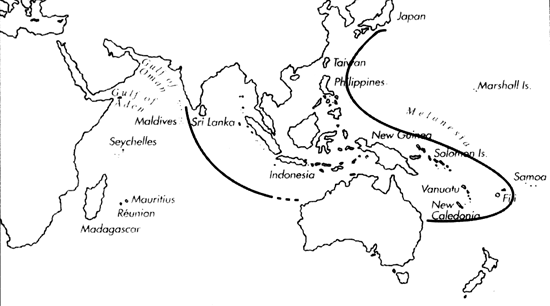
Skip Navigation Links
View access keys for this site.

Range: Japan to Philippines and Melanesia to Fiji; India to Indonesia.
Description: Medium-sized to large, moderately solid to solid, lightest in form brettinghami. Last whorl conical to ventricosely conical, broadest in form samiae; outline almost straight, left side sometimes concave near base. Form samiae with more convex sides than other forms. Shoulder angulate, strongly tuberculate to weakly undulate with about 10- 14 broad tubercles or bulges. Spire of low to moderate height, outline concave to almost straight. Larval shell of 3 or more whorls, maximum diameter 0.8-1 mm. Teleoconch spire whorls tuberculate to undulate. Teleoconch sutural ramps concave, with 1-2 increasing to 5-12 spiral grooves; in form samiae increasing to 4-7 grooves. In typical form and in form samiue, last whorl sculptured with broad, often pustulose spiral ribs and/or ribbons; grooves between axially striate and often containing 1-3 spiral threads. Forms bocki and brettinghami usually nearly smooth or weakly sculptured.
| Shell Morphometry | ||
|---|---|---|
| L | 48-89 mm | |
| RW | - | |
| RD | - | |
| PMD | - | |
| RSH | - | |
Ground colour white. Last whorl variably suffused or streaked with yellowish to dark brown. Almost uniformly brown shells intergrade with largely white shells. Shoulder edge usually white. Form samiae with rows of brown spots on spiral elevations of last whorl, fusing or concentrating into 2-3 spiral bands. Larval whorls and adjacent postnucelar sutural ramps immaculate, following sutural ramps maculated with brown radial markings, ranging from mainly brown to mainly white. Aperture white.
Periostracum greyish to brownish olive, moderately thick, slightly translucent to opaque, with fine spiral and axial ridges bearing fine hairs.
Habitat and Habits: In 20 to 240 m.
Discussion: Old (1973) and Coomans et al. (1982) considered 3 allopatric subspecies: C. s. sulcatus from Taiwan, with strongly sculptured last whorl, but rather weakly tuberculate shoulder, and white to blurred- brown in colour (Pl. 47, Figs. 4-6). C. s. brettinghami from Philippines and possibly also New Guinea, with narrower last whorl, the upper half smooth, almost solid brown and undulate to weakly tuberculate shoulder (Pl. 47, Figs. 7-9). C. s. bocki from W. Thailand, throughout Indonesia and the Solomon Is., with a broad last whorl, strongly tuberculate shoulder, variable in sculpture of last whorl, and brown (Pl. 47, Figs. 10-13). Although local populations seem to be uniform in their conchological appearance, these three variants all intergrade with one another, and all occur sympatrically. We thus consider them forms rather than subspecies. Typical form: Japan to Philippines, Vietnam and Indonesia; form brettinghami: India, W. Thailand, Philippines to Melanesia; form bocki: W. Thailand, Philippines and Melanesia; form samiae (Pl. 47, Figs. 14-16): Philippines and Solomon Is., intergrading with form bocki. The typical form of C. sulcatus may resemble C. asiaticus. The latter species is smaller, has smooth late sutural ramps including shoulder, a higher spire (RSH 0.15-0.20), and a larval shell of 2-2.5 whorls (vs. 3 or more whorls). For comparison with C. rolani and C. helgae, see the Discussions of those species.

C. sulcatus range map
This section contains verbatim reproductions of the accounts of 316 species of Conus from the Indo-Pacific region, from Manual of the Living Conidae, by Röckel, Korn and Kohn (1995). They are reproduced with the kind permission of the present publisher, Conchbooks.
All plates and figures referred to in the text are also in Röckel, Korn & Kohn, 1995. Manual of the Living Conidae Vol. 1: Indo-Pacific Region.
The range maps have been modified so that each species account has it own map, rather than one map that showed the ranges of several species in the original work. This was necessary because each species account is on a separate page on the website and not confined to the order of accounts in the book.
Return to framed version (returns to search page)